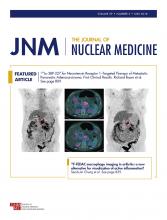REPLY: We thank Bela Denes and Peter Gardiner from BlueEarth Diagnostics, Inc., for their interest in our case series (1) and their relevant letter. BlueEarth Diagnostics, Inc., showed recently with great success how to get a PET probe approved by the Food and Drug Administration (2). We agree with each of their comments and concerns. We clearly highlighted the limitations throughout the article and, in particular, in the discussion section (1).
Nevertheless, we are convinced that the cases may be informative even after considering the limitations that they and we highlighted. Except for 1 patient (patient 3), the difference in prostate-specific antigen (PSA) levels between the 2 scans was minimal: median, 0.11 ng/mL; mean, 0.24; range, 0.03–0.86 (1). Prostate-specific membrane antigen (PSMA) signals were entirely unambiguous, and we did not rely on CT to call findings positive or negative. We also agree that false-positive PSMA PET/CT findings can occur. However, the reported specificity and positive predictive values of PSMA PET/CT, especially for local and nodal disease, are reported to be very high (i.e., >95%) (3–6).
The findings of the 2 imaging tests were so strikingly different that we felt a brief report would be prudent because no direct comparisons between these 2 tests have been published thus far. These differences are not surprising as amino acid transport and PSMA expression reflect fundamentally different biologic processes. We believe that lesion phenotypes such as concordant and discordant findings by these 2 imaging tests may give rise to future important research by, for instance, correlating these patterns with patient outcomes.
We strongly support the notion that 18F-fluciclovine PET/CT has significantly improved the management of prostate cancer patients as documented in well-designed clinical trials (NCT01666808, NCT02578940). We acknowledge with great enthusiasm that the inclusion of 18F-fluciclovine PET/CT in the American College of Radiology Appropriateness Criteria guidelines, as well as most recently in the National Comprehensive Cancer Network guidelines, is a major milestone for improving the care of prostate cancer patients.
We simply reported that 7 of 10 patients who underwent 18F-fluciclovine PET/CT before enrollment in our ongoing prospective trial (NCT02940262) exhibited more positive findings on 68Ga-PSMA-11 PET/CT scans. Although far from definitive evidence of superiority, these unexpected findings encouraged us to initiate a prospective single-center trial to compare 68Ga-PSMA-11 and 18F-fluciclovine PET/CT for restaging prostate cancer patients with biochemical recurrence after radical prostatectomy at low PSA values (UCLA IRB# 17-001885, NCI identifier 2018-00546).
Footnotes
Published online Mar. 1, 2018.
- © 2018 by the Society of Nuclear Medicine and Molecular Imaging.







